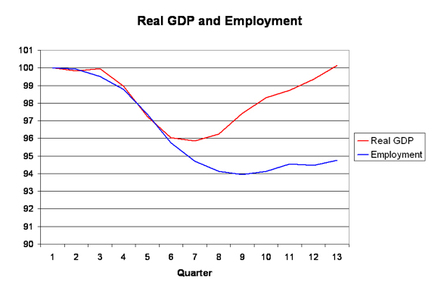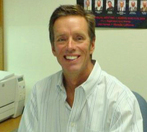Someone sent me a link to this video last week. I initially paid little attention to it, as I do with the many similar messages I receive daily. I did, however, end up loading and watching the video a couple of days later, and am very glad I did. As I watched the video I realized just how applicable to my work as a trainer this video could be. My thinking is I can use this video as an indicator of my toughest customers. I will play the video at the beginning of my training session and note those who don't laugh; these will be the ones that may have difficulty getting my brand of humor :) Additionally, I believe this video is a strong reminder of how much wonder we lose as we "grow up". That message too is a central theme in many of sessions; have a sense of wonder in everything you do, and use that wonder to think outside the box. Doing this, I believe, will bring a renewed sense of excitement to what you do with your life; personally and professionally. Enjoy.
This is the title that caught my attention as I looked through the brochure of an upcoming HR conference. It went on to describe the "Thiagi Four-Door Model", or 4D. I have been involved in training and development many years now, and have prided myself of keeping my finger on the pulse of the industry. And, although i have integrated learning activities (AKA games) into my materials many years ago, somehow Sivasailam Thiagarajan slipped by me without even noticing. Now, that may be my fault entirely; perhaps my finger has been placed as squarely on the industry as I had believed. Nonetheless, Thiagi seems to have a pretty keen idea with his 4D model, and this little post is my attempt to spread the word about it's potential benefits, for all of us; trainers, learners, facilitators, managers, organizations - everyone. So, I have a few links for you to investigate; consider these the "library" door. Sorry, I don't have the time to create an entire 4D implementation to introduce you to Thiagi, but we could use this blog for one of the other doors in his model; the social arena - after all I have named this blog the HR Salon. So, go have a look at the links, find other material, and come back here to share your impressions, and by all means if you have been using this model, do share some examples so we can all benefit from your experience.
Some "library" links for your viewing pleasure: Two part interview with Russ Powell; he worked with Thiagi using the 4D model; A great video of Thiagi speaking to students at UMBI - warning the video is long, but the content covered will give you a good feeling for the Thiagi's perspective, and a deeper understanding of the 4D model. Lastly, here is a link to some great podcast content on Thiagi's own website. Again, maybe you all knew about Thiagi all along, but at the risk of appearing at the back end of the curve, I wanted to post this information in the hopes that at least one person is introduced to something that could drastically change how they teach and learn. I have been reading some articles in various publications lately, and it got me to thinking; remembering actually. I recall the book by Charles Handy; The Age of Paradox. I read this book back in grad school, and his idea of a "doughnut organization" was pretty ahead of the curve at that time. The concept posits that organizations can become lean and facile by focusing on a critical core group of permanent employees, who then use key groups of temporary workers to either manufacture the goods and/or deliver the services of that organization. Back in 1994, I thought that was some really forward thinking, and I still do. The concern I now have is that Mr. Handy may finally be seeing his prognostication come true. I feel differently now about this idea, then I did back in 1994, now that I see a lot my world through the lens of an HR person. Some of the questions that necessarily come from this dynamic are macro; what about all of the permanent employees and our national unemployment rate? Do we need to prepare these otherwise permanent employees for a life of temporary work, which brings up a whole host of questions about the infrastructure we would have to put in place to meet the needs of these newly "temped" employees. Other questions I have are micro; how must we change our current understanding of HR, leadership development, motivation theory, etc. to account for an entirely different kind of workforce with a completely new set of needs and motivations? I have obviously oversimplified Handy’s fairly complex ideas, however, I think you have enough to respond to the ideas/questions presented here. Also, if you want to read a more deeply about Handy’s concepts before commenting, click here to read a Google excerpt of his book. Thanks and are you thinking of having a doughnut with that coffee?
Here is a link to a great article I read in the Economist today. I have been thinking a lot about the term "jobless recovery" lately, and this article got me wondering even more. If we are indeed into a jobless recovery, what are the ramifications for HR? If less people are being hired, but the work is picking up, are we expecting more work from a smaller worker population? If so, how long do we think that can last without burnout, absenteeism, and finally exits? Also, what about the effect of workers who stay longer than they would otherwise; not moving on to their next place? Without "new blood" in the organization, don't they begin to loose their edge, that juice that keeps them competitive? There are lots more HR related questions, so please ask/answer them here. Please weigh in on what appears to be our new reality. If you still need convincing, take a look at the graph below, which is one of the graphs the author shows in the article. Scary, right?
Look forward to your thoughts on this BIG issue. The main goal of this blog is offer a place for dialog, a salon if you will, for all things HR. Having spent the last 6 months preparing for, and passing the SPHR exam, I am full of ideas, and questions about what the future of HR holds. I have recently read with interest numerous opinions about HR as a business partner, and can't help but wonder if some out there are expecting too much from HR? After all, what is the possibility of "moving beyond your title" given the political reality of organizational boundaries. I know by simply writing that statement, I have already "shown my cards" and invite much retort. To that I say, excellent! That is exactly what I hope to accomplish with this venue; a place where all thoughts are heard. Of course, as with a physical salon, we all need to be respectful of all others, and be open-minded to the possibility that there may be more than our reality to a given problem, issue, opportunity.
So, how about it; where is HR headed, and can we truly be HR business partners given the nature of humans and the structure of organizations? I look forward to a spirited exchange of ideas about something for which there simply may not be a solution. Welcome to the HR Salon To leave a comment, simply click on the comment(s) link at the top of this entry. |


 RSS Feed
RSS Feed